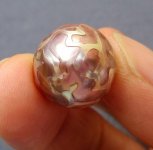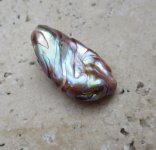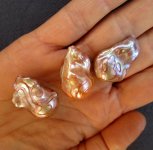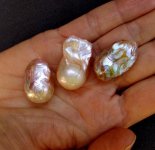Michelangelo said: "I saw the angel in the marble and carved until I set him free". I think of that quote whenever I see the pearl carving work of Eric Windeck.

The nature of nacre is sometimes mysterious. Under the surface, nacre can be wildly capricious—meaning that peeling back a layer of nacre on a cultured pearl may reveal an unattractive proteinaceous layer, air pockets, dull patches, or possibly worst of all—an implanted nucleus.
In the above examples, Eric has used his skills to remove enough surface nacre from each type of pearl to make a pattern, change the color, or just render the pearl more interesting or more beautiful than it was in its pristine state.
Here at Pearl Guide, we have been on a journey with Eric, member EricW, who has faithfully posted his efforts as he mastered carving each type of pearl. At times, he was completely surprised by what he found inside.
On this Edison-type freshwater cultured pearl, the inner nacre layer is just as lustrous as the surface, but a completely different color. The difficulty in removing such a thin layer cannot be overstated.

The colors can be mesmerizing. The blue orient and gold "pond slime" coating make this lavender pearl a galaxy of iridescence.

While nacre depth can be expected to be deeper on Tahitian or South Sea pearls, they don't always offer interesting contrasts in carving. A different set of challenges is encountered in this set of "fireball" or "flameball" pearls below. In the second photo, you can clearly see the presence of the nucleus in the center pearl. What a wonder then, that the carving continues, ever so delicately, if not perfectly, across the entire pearl.


To see more of Eric Windeck's pearls, visit his website www.pearlew.com
All photos courtesy of Eric Windeck.
Blaire Beavers
Managing Editor
Pearl Guide News

The nature of nacre is sometimes mysterious. Under the surface, nacre can be wildly capricious—meaning that peeling back a layer of nacre on a cultured pearl may reveal an unattractive proteinaceous layer, air pockets, dull patches, or possibly worst of all—an implanted nucleus.
In the above examples, Eric has used his skills to remove enough surface nacre from each type of pearl to make a pattern, change the color, or just render the pearl more interesting or more beautiful than it was in its pristine state.
Here at Pearl Guide, we have been on a journey with Eric, member EricW, who has faithfully posted his efforts as he mastered carving each type of pearl. At times, he was completely surprised by what he found inside.
On this Edison-type freshwater cultured pearl, the inner nacre layer is just as lustrous as the surface, but a completely different color. The difficulty in removing such a thin layer cannot be overstated.

The colors can be mesmerizing. The blue orient and gold "pond slime" coating make this lavender pearl a galaxy of iridescence.

While nacre depth can be expected to be deeper on Tahitian or South Sea pearls, they don't always offer interesting contrasts in carving. A different set of challenges is encountered in this set of "fireball" or "flameball" pearls below. In the second photo, you can clearly see the presence of the nucleus in the center pearl. What a wonder then, that the carving continues, ever so delicately, if not perfectly, across the entire pearl.


To see more of Eric Windeck's pearls, visit his website www.pearlew.com
All photos courtesy of Eric Windeck.
Blaire Beavers
Managing Editor
Pearl Guide News

